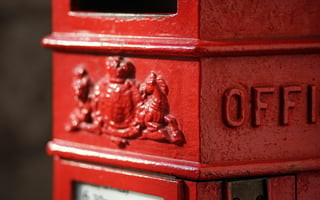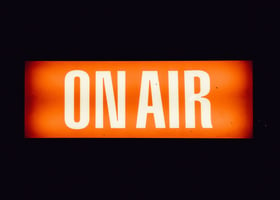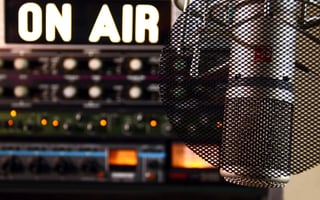Doorstep interviews are notoriously difficult to handle.
Radio, print and TV interviews all have their specific requirements.
But there is much more to it than those three categories, with each medium throwing up a range of different interview formats, each with its subtle nuances, which could trip up or unsettle an unsuspecting spokesperson.
That’s why we offer every conceivable media interview format on our media training and crisis communication courses.
Broadcast interviews
TV Studio interviews
Television studios can feel like an alien and daunting environment for even seasoned media spokespeople.
These places are often filled with industry-specific phrases, terminology and acronyms, which typically mean little in the outside world.
Working TV studios can be cluttered with a variety of used and unused equipment, wires and lights. While you try and compose yourself, technicians, editors, presenters and producers will be busy whizzing around you. There can be a lot to take in, and they can sometimes feel like chaotic places.
The best way to prepare for this situation is by removing some of its mystique. That’s why we carry out our media training in a realistic studio environment. Our broadcast quality studios help spokespeople find their feet in this environment.
Down-the-line
Due to cost and time challenges, this is a favoured format of the rolling 24-hour news channels and is also used on all other TV news programmes.
While these types of media interviews are typically shorter than face-to-face studio ones, they are a particularly challenging and uncomfortable format for spokespeople.
They often find themselves tucked away in a remote studio, needing to use an earpiece and unable to see the person they are talking to.
Although rare, sometimes they won’t even have a technician to help them turn on the TV or studio lights. These self-operated down-the-line studios could be particularly nerve-wracking.
Many spokespeople have made memorable gaffes during down-the-line interviews, such as Sainsbury’s CEO Mike Coupe being recorded singing ‘we’re in the money’ as he prepared to discuss his company’s plans to buy rivals Asda.
Our courses offer down-the-line interviews so spokespeople are aware of these pitfalls and know where to look, how to get their body language right and how best to deal with those fiddly earpieces.
The doorstep interview
We’ve all seen this interview format on news programmes. Someone comes out of their home or office to be greeted by a crowd of journalists shouting questions.
It can be scary and intimidating, and many spokespeople, including some with vast amounts of media experience, are unable to resist the urge to run away.
The problem with that strategy is it creates dramatic footage and audio and suggests organisations may have something to hide. And the media will not go away until they have heard from you.
We can carry out these types of media interviews – sometimes referred to as ambush interviews - on our media training and crisis communication courses, often greeting delegates as they arrive with a camera crew and a journalist demanding answers.
We’ll then show them how best to prepare for this interview format should it happen again in the real world.
The sofa interview
You’ve probably seen these media interviews on breakfast television programmes, and they can often appear quite relaxed.
And that is one of the biggest traps with this format – spokespeople are led into a false sense of security on the comfy sofa and then start to flounder when they are hit by a difficult question they weren’t anticipating.
Body language is also crucial here. It can be easy to sink into an over-relaxed pose, removing the energy and dynamism needed to get a message across successfully.
Our studios can replicate this format so spokespeople know how to make the most of the opportunity if they find themselves on shows like BBC Breakfast and Good Morning Britain.
Outdoor broadcast interviews
This is another one of the common interview formats.
You can probably recall footage of construction firm CEOs being interviewed on building sites or highway officials facing questions with a busy motorway behind them.
While being interviewed away from the studio in a more natural environment can be relaxing, this is also a format riddled with distractions.
Cars beeping horns, nosey passers-by and even freak gusts of wind can knock spokespeople off their stride and prevent them from successfully delivering the message they wanted to get across.
The outdoor broadcast interview can also take the form of a down-the-line interview, with questions coming from the studio rather than a journalist at the location.
The Skype / Zoom / Teams interview
This format became somewhat infamous when an interview on BBC News with Professor Robert Kelly was hilariously interrupted by his children.
Similar to down-the-line interviews, these media interviews enable news channels and radio stations to quickly and cheaply interview spokespeople across the world. And in terms of sound quality, it is only beaten by being in the studio and ISDN.
Consequently, it is a format which is becoming increasingly popular.
But, while interviewing from the comfort of your home or office may sound more relaxed, there are still many pitfalls for spokespeople.
Sound bite interviews
Your spokesperson could be asked to deliver a sound bite as part of a pre-recorded interview for radio or TV.
It may be used to tease a longer interview later in the news programme or might be needed in case your story slips down the news running order, and there is only time for a short clip.
On other occasions, a sound bite may be needed so that a journalist can add balance to an item with conflicting views.
This format presents an opportunity for spokespeople to get their message across clearly and concisely – but this also presents a real challenge, with sound bites rarely lasting longer than 15 seconds and sometimes being as short as six seconds.
Spokespeople often find this one of the hardest types of interviews.
Live versus pre-recorded interviews (TV and radio)
The addition of the word ‘live’ to an interview request can turn a normally composed and assured spokesperson into a nervous and suddenly reluctant one.
There is a feeling that the stakes are higher and that mistakes, which cannot be corrected, will be broadcast to millions of people.
Pre-recorded interviews, on the other hand, appear to offer the safety net that spokespeople can have another go at an answer.
But while it may feel daunting, a live television or radio interview has many advantages. They are generally shorter, your spokesperson will typically get more airtime, and the journalist cannot exercise any editorial control over what part of the interview can go out.
A pre-recorded interview does give a spokesperson the option of responding to questions again, but these interviews generally go on for much longer and yet they might still be reduced to a 15-second sound bite when they are aired.
Our media training courses will help spokespeople feel comfortable in both interview formats and ensure they get their message across successfully.
Multi-guest interviews (TV and radio)
Interviews with multiple interviewees can present spokespeople with unique challenges.
While the journalist should try to ensure everyone has the same opportunity to give their views, it can be tricky for spokespeople to be heard without appearing rude or aggressive – something which will not win them the support of the audience.
All too often, we see and hear these types of interviews descend into little more than an on-air argument where it is impossible to hear the points being made.
This format becomes even trickier if your spokesperson appears from a different studio to the journalist and other guests.
TV green screen
These interviews are more commonly used in corporate videos, but can also be used in remote or satellite studios where there isn’t a good view to use as a backdrop. The green screen enables a background, such as the London skyline, to be imposed on to the interview.
It can all be a little unnerving for spokespeople as the lighting is different, and they are filmed in an odd setting with a fluorescent green, or sometimes blue or grey, background.
Radio studio
Similar to a TV studio interview, a radio one can feel like an odd environment for spokespeople with plenty of strange equipment in the room.
Studio radio interviews often take place early in the morning to provide content for the crucial breakfast slots, and they can be particularly short – sometimes as little as two minutes – so interviewees need to ensure they get to their message quickly.
It is worth remembering many radio stations also have cameras in their studios providing content for their social media channels. So, even though you are on the radio, body language is still vital. Prime Minister Gordon Brown found this out during the 2010 General Election when footage emerged of him sitting with his head in his hands during a radio interview.
Radio telephone
Many radio interviews are now done over the phone thanks to the obvious time-saving benefits this format offers.
Even high-profile national radio programmes like Radio 4’s Today will sometimes interview someone over the phone.
In our experience, most producers like to call the spokesperson, and timings can vary greatly. Sometimes the call will be made several minutes before the interview, and the spokesperson can hear the programme through the handset and get a feel for what is being said.
But it is also known for spokespeople to go live almost as soon as they answer the call, which can be daunting.
Interruptions, occasional sound quality problems and tight time frames are among the other issues spokespeople can face in this format.
Radio Skype interviews
Skype and FaceTime offer great advantages for radio stations. They can interview someone almost anywhere in the world and quickly gather audio which can be used on air.
In fact, the sound quality is typically better than someone on a telephone.
But this technology wasn’t designed for radio, and there are steps spokespeople need to take to ensure they make the most of interviews carried out through this format.
Did you know, for example, that turning off video will make the sound quality even better?
Radio outside broadcast
Sometimes radio stations will decide to take their show on the road and broadcast from a remote location.
On other occasions, a reporter will conduct their interviews out on location.
Being interviewed outside can have its advantages for spokespeople. But it is not without its difficulties. Distractions can be problematic in this format, particularly if the interview is being recorded. A spokesperson could be asked to answer the same question again because a passing car, for example, disrupted the audio on the original attempt.
Interviewees might also be asked to help with audio ideas for the wider news package. A senior police officer I once put forward for interview was asked to repeatedly shout ‘strike, strike strike’ into a microphone to try to recreate the dramatic start to a drugs raid.
As with radio studio interviews, it’s important to remember that the journalist may be armed with a camera to capture footage for social media channels and websites.
Face-to-face:
This is the traditional way print interviews are carried out.
Often they will take place at an arranged time at your offices, but they may also happen at industry events, conferences and trade shows.
On proactive subjects, in-person interviews can feel relaxed, if a rapport is built with the reporter. The risk here is spokespeople become too chatty and veer off-topic.
These interviews can be long and winding, with the journalists not leaving until they have got a good story – even if it wasn’t the one they set out to report on.
The modern journalist may record the interview on their phone, but many still rely on traditional shorthand notes.
Telephone print
Telephone print interviews have become an increasingly common format, particularly as the number of journalists has declined in recent years and those that remain in the industry have fewer opportunities to leave the newsroom.
They are typically shorter than the face-to-face format, but they can also be a lot more challenging for spokespeople.
It is harder to build any rapport with the reporter, and often journalists find it easier to be tougher and more aggressive on the phone.
We replicate this on our media training courses by creating a telephone interview with a journalist the delegates have not previously met. And the end of the course, they receive a write-up of the start of their story, together with some feedback, to see whether they were able to get their key message across.
Media First are media and communications training specialists with over 30 years of experience. We have a team of trainers, each with decades of experience working as journalists, presenters, communications coaches and media trainers.




